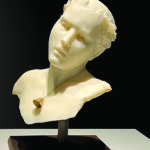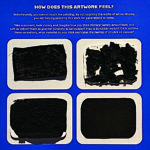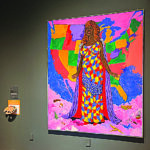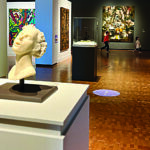My exposure to galleries and museums started during my early college years. Creating art came first, and then my fascination with art history followed.
Shortly after graduating college, I was able to travel to Europe. During a visit to Amsterdam, my excitement to get a closer look at how Dutch masters painted lace was abruptly interrupted by a museum guard. I still blush at my blunder.
Over the years, my interest in art history evolved into a passion for sharing it with my high school art students. Navigating the complexities of art etiquette, especially with the rise of contemporary installation works, has its challenges.

‘Bell’ 2023 Cast glass, gold leaf, bell, and steel Made with the assistance of Melanie Hunter and Randy Reid. Museum purchase made possible from the Anniversary.
NICHOLE GRONVOLD-ROLLER
Balancing between encouraging viewer engagement and respecting the sanctity of works of art requires reflection. Sometimes, artists invite viewers to engage, while other times, a hands-off approach is preferred.
The “FRESH: New Directions in Contemporary Art” exhibition at Peoria Riverfront Museum provides a compass for novice and seasoned art enthusiasts with the latest additions from Alice Walton’s Art Bridges Collection. Supported by the Art Bridges Foundation, the Bielfeldt Foundation, the Visionary Society, and Friends of Art — the exhibition promises “fantastical revelations of the visual art vernacular.” Click here for more from the Peoria Riverfront Museum
Upon entry, visitors are welcomed by Bill Conger, Curator of Collections and Exhibitions, with a virtual curation highlighting prominent artists and concepts that shape the contemporary art landscape.
Walking clockwise through the museum gallery, one first encounters the vulnerable presence of Richard Tuttle’s “In Praise of Historical Determinism (I, II, and III)” 1973-74. The deliberate placement of the lithograph and screenprint on handmade paper courtesy of the Jeff and John Heintzman Collection sets the tone for the entire exhibition.

Tactile simulation of the 2009 oil stick on paper ‘Artaud’ by Richard Serra b. 1938 (American) — courtesy of Art Bridges Foundation. NICHOLE GRONVOLD-ROLLER
Tactile simulations accompany a selection of artworks. One work with an enticing hands-on nature is Richard Serra’s “Artaud” (2009), an oil stick on paper courtesy of the Art Bridges
Foundation. A texture model is offered to help ward off any temptation of touching the original, in addition to a cordoned-off area just in case.
While documenting images of “Teresa,” a sculpture crafted from luminous cast glass and steel, I overheard the murmur of children laughing, delightfully filling the space while chanting, “Don’t touch, don’t touch.” An adult nearby keeps up with the children, echoing their comments, “Yes, don’t touch, but you can touch this.”
Active discussions should be encouraged within the exhibition context; it is okay to linger but be considerate of others.
Remember, if ever in doubt, seek assistance from gallery or museum staff — don’t be embarrassed; you may save yourself from more considerable discomfort. Art should be experienced, especially in person; you have that right, no matter the level of expertise.
As a final piece of advice, I recommend not standing on any benches to get a closer look at the artwork — even if you are curious about how Dutch masters paint lace eloquently with only a few brush strokes. While their mastery is undeniably impressive, it’s best appreciated from a respectful distance.
Museum etiquette and avoiding errors

Robert Colescott, ‘Miss Liberty,’ 1980. Acrylic on Canvas. On display at Riverfront Museum courtesy of Art Bridges Foundation.
NICHOLE GRONVOLD-ROLLER
In 2016, “Travel + Leisure” listed “Fifteen Museum Etiquette Errors And How to Avoid Making Them.” It still holds relevancy today but with flexibility and consideration of the space and intention of the exhibition.
- Be quiet
- Check your bags
- Do not crowd the artwork
- Do not block the art
- Do not take phone calls
- Instagram doesn’t need to be instant
- Do not use the flash
- No selfie sticks
- Do not photograph everything
- Watch your step
- Keep up with the pace
- Do not feel like every work has to make you feel something
- Do not touch anything
- Do not lean on the walls
- Do not eat, drink, or vape


